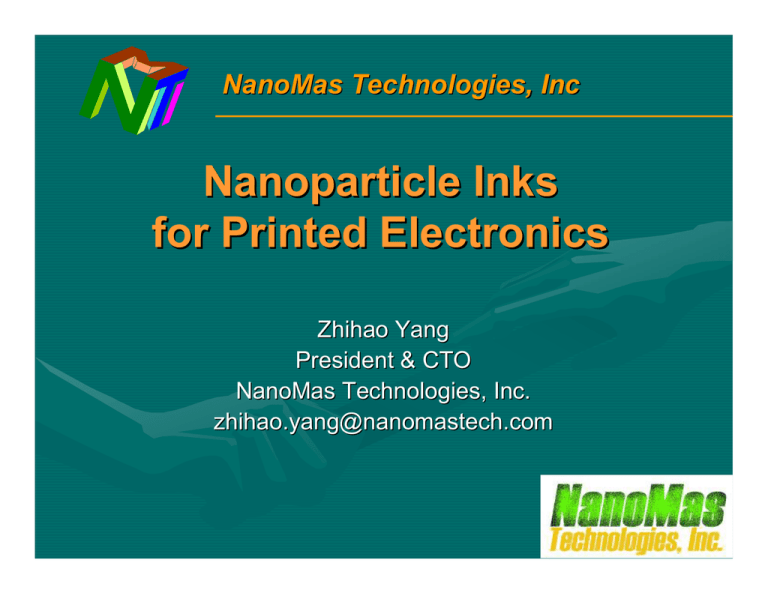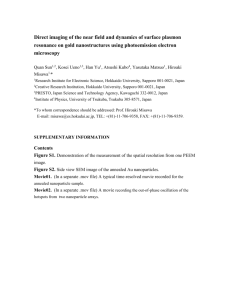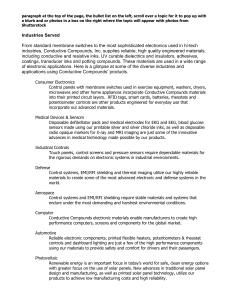Nanoparticle Inks for Printed Electronics NanoMas Technologies, Inc Zhihao
advertisement

NanoMas Technologies, Inc Nanoparticle Inks for Printed Electronics Zhihao Yang President & CTO NanoMas Technologies, Inc. zhihao.yang@nanomastech.com Technology Revolutions in Electronics for the Past 100 Years • Vacuum Tube Transistors: 1906 by Lee De Forest • Solid State Transistors: 1947 by John Bardeen and Walter Brattain (Bell Telephone Laboratories) • Integrated Circuits: 1958 by Jack Kilby (Texas Instruments) What Next? The industry has followed the prediction of Moore’s Law for the last 40 years without major technology revolution. Moore’s Law: The number of transistors per unit area is doubling every 1.5 years. --Gordon Moore (founder of Intel Corporation). Moore’s Law is reaching its physical limit in next 5 to 10 years. What will be the next technology revolution in the electronics industry? Look beyond the Silicon Low-Cost ICs on Arbitrary Substrates Polymeric substrate AMLCD a-Si:H strain bridge array Pentacene organic circuits on polymeric or cloth substrates Plastic solar cell a-Si:H active matrix Gamma ray detector on polyimide substrate Large Area & Flexible Displays Flexible active matrix e-paper SVGA display (Plastic Logic) World's thinnest flexible activematrix display (Philips) The plastic TFT-LCD display (Samsung) World's first 3mm thick flexible digital watch (Citizen) Low-cost RFIDs and Disposable Electronics Current cost: 7-10 cents per tag Target cost: 1-2 cents per tag Printed Electronics Manufacturing Tremendous Market Growth Potential for Printed Electronics in Next 20 Years 2011 Total PE Reveue $12,385 (in Million) $14,000.0 $12,000.0 $ in Million $10,000.0 (Data from NanoMarkets LLC) (Data from NanoMarkets LLC) Other (21% Overall), $2,601 Printable Display, $3,801 $8,000.0 $6,000.0 Printable Photovoltaic, $1,042 $4,000.0 $2,000.0 Printable Backplanes, $1,134 $0.0 Printable Signage, 2006 2007 $1,250 2008 RFID, $2,557 2009 2010 2011 Year Recent report by IDTechEx predicts the PE market will reach $300B in 2027 Printed Conductors Highly conductive and high resolution patterns fabricated using low-cost and roll-to-roll processes (such as inkjet and gravure printing) are one of the most critical technology components in making printed electronics and displays NanoMas Solutions: Make conducting patterns using metal nanoparticle inks! Market of Applications: Flat panel display backplanes (TFT electrodes and bus-bars) EMI Shielding : plasma display, LCD, etc RFID tags Electroluminescent lighting Printed circuit boards (PCBs) Touch screens Technology Comparison for Printed Conductors Vacuum Processed Evaporated Metals Sputtered ITO Printable Metal Nanoparticle Inks Silver Micro-Powder Pastes Carbon Nanotubes Conductive Polymers Resistivity 10 100 Conductivity 10-1 100 10-1 10-2 10-3 10-4 10-5 10-6 (Ohm-cm) 10 102 103 104 105 106 (S/cm) Size-Dependent Melting Point of Nanoparticles 2 ρs 3 Tb − Tm 2 = γs −γl Tm L ρ s Rs ρl Small particle size (in nanometers) significantly reduces the melting temperature of NPs from the bulk melting point, allowing for very low processing temperatures (based on surface melting) for sintering NPs into conducting films. Ph. Buffat and J-P. Borel, Phys. Rev. A, 13, 1976, 2287 Nanoparticle Inks for Printed Electronics • Nanoparticles can be stabilized in ink solutions by organic ligand shells, which can be removed after printing. • Nanoparticles can be further cured or sintered to highly conductive films at low temperatures. 70-90°C 100-150°C Deposited Ag nanoparticles Conductive Ag film on PET cured from printed nanoparticle inks 150°C 200 nm NanoMas Proprietary Technology: Producing High Quality Nanoparticles with Large-Scale and Low-Cost Processes NanoMas silver nanoparticles with 5-6 nm in size (SEM) A 50L pilot production reactor at NanoMas NanoMas Ag nanoparticle powders and inks NanoMas Proprietary Printable Metal Nanoparticle Conductive Inks Technology • Unique all solution based nanoparticle synthesis technology (patent pending), widely compatible with the low cost production processes in the chemical industry • Low cost and fully scalable to large scale mass production – Scaled up to pilot production with a 50 litter reactor • Ultra-small nanoparticle size (2 to 10 nm) with specially designed surface chemistry allows low annealing temperature, short process time, and high conductivity • Variety of surface chemistry for different solvent dispersion and applications • Low resistivity (as low as ~2.3 µΩ-cm, 1.5x of pure Ag) • Low process temperature (as low as ~90°C) compatible with most plastic substrates • Also curable by laser or UV light at room temperature UV-vis Characterization of NanoMas Gold and Silver Nanoparticles Ag nanoparticles in cyclohexane (λmaxNano-Ag ~ 416 nm) Au nanoparticles in cyclohexane Nano-Au Nano-Au (4 nm) nanoparticle solution in cyclohexane Nano-Ag (5 nm) nanoparticle solution in cyclohexane UV-Vis Absorption Spectra of Au and Ag Nanoparticle Solutions NanoMas Au Nanoparticles (<5 nm) DSC TEM • DSC: exothermic sintering between 180ºC and 210ºC • TGA: ~10-15% weight loss between 180ºC and 250ºC due to loss of surface capping agent • Resistivity: ~8 µΩ-cm (annealed at 200°C, 3x of bulk Au) NanoMas Ag Nanoparticles DSC TEM sintering ECD Distribution of ZHY-050616 by TEM 0.30 Metric Value Mean ECD [nm] 5.72 Std Dev ECD [nm] 1.79 Count 726 GMD ECD [nm] 5.43 GSD 1.41 Fit GMD [nm] 5.98 Fit GSD [nm] 1.24 0.25 • DSC: exothermic sintering between 110ºC and 160ºC • TGA: ~10% weight loss between 100ºC and 200ºC due to loss of surface capping agent • Resistivity: 2.4 µΩ-cm (annealed at 150°C, 1.5x of bulk Ag) Frequency 0.20 0.15 0.10 0.05 0.00 -0.05 1 10 ECD [nm] Frequency Data Particle size:Lognormal 6 ±1 Fitnm 100 Small Angle Neutron Scattering (SANS) Characterization of NanoMas Nano-Ag SANS of Packed Nano-Ag (Solid) SANS on Nano-Ag Solutions (10 wt% in d-Toluene) 1.0 SANS Data Core-Shell Model Fitting Scattered neutron -1 Intensity (cm ) 0.5 0.0 Incident neutron 5 sample-1.0 -1 Intensity (cm ) 4 Qmax= 0.120 Ǻ-1 -2.0 Core radius: radius: 23 23 ±± 11 Ǻ Ǻ Core Core radius radius σ: σ: 5.5 5.5 Ǻ Ǻ Core Shell thickness: thickness: 66 ±1 ±1 Ǻ Ǻ Shell θ -1.5 -1.0 -0.5 Log (Q) [A] 3 detector 2 1 interparticle distance ~ 5.2 nm 0 -0.5 0.05 0.10 0.15 Q (A) 0.20 0.25 SANS spectra confirmed that the Nano-Ag has an Ag core diameter of 4.6 ±1.1 nm and a 0.6 ±0.1 nm thick shell in solvent or a 0.3 nm shell in packed (solid) state. Superior Performance of NanoMas NanoSilver Inks due to the Ultra-Small Nanoparticle Size 25 PET Cabot PED (20-30 nm) ManoMas (~ 5 nm) NanoAg (~25 nm) from competitors Resistivity ( µΩ-cm) 20 15 Kapton NanoMas NanoAg (5 nm) 10 5 Ag bulk resistivity 0 NovaCentrix 100 150 (~20 nm broad distribution) Annealing 200 Cima NanoTech (80-100 nm) (C) Temperature 250 Printed Conductive Patterns on Plastic Substrates 13.56 MHz RFID antenna printed on PET and polyimide Miniature RF coil printed on PET Printed flex circuit on polyimide Inkjet Printed NanoSilver Contacts in Fabricating a-Si:H TFTs on Glass Probes Source Drain L (µm) µ (cm2/Vs) VT (V) 110 140 ~ 0.91 ~ 0.97 ~ 1.68 ~ 1.41 * Data curtsey of Dr. Yongtaek Hong of Seoul National University, Korea VDS = 40 V L = 110 um L = 140 um 200 100 -5 10 -6 10 0 -10 0 10 20 VGS (V) 30 40 IDS (uA) -4 10 IDS (A) Ag (~ 30 nm) Cr (~ 5 nm) n+ a-Si:H (~ 50 nm) a-Si:H (~ 200 nm) a-SiNx:H (~ 300 nm) Cr (~ 35 nm) Glass Substrate Printed NanoSilver Contacts in Fabricating Organic TFTs Ag PQT Ag Silicon dioxide gate dielectric Single crystal silicon gate • Organic Semiconductor: poly(3,3 didodecyl-quaterthiophene) or PQT-12 • Source and drain printed with NanoMas NanoSilver inks and annealed at 145ºC • Device channel length of ~43 um and width of ~300 um • No obvious contact resistance * Data curtsey of Dr. Jurgen Daniel of PARC Inkjet Printed TFTs with ZnO and Ag Nanoparticle Inks • Print or coat with ZnO nanoparticle ink • Heat step at 200 C to anneal • Print silver nanoparticles for source/drain, and annealed at 150C Log(Id) ZnO TFT with printed Ag contacts 1.0E-04 1.0E-05 1.0E-06 1.0E-07 1.0E-08 1.0E-09 1.0E-10 8.0E-03 6.0E-03 4.0E-03 2.0E-03 0.0E+00 -30 Mobilities: 0.1-0.15 cm2/Vs On/Off: ~105 -10 10 Vg 30 50 About Cost… • What Printed Electronics should shoot for are high productivity, large size and volume, high flexibility, and ultimately the LOW COST. • The nanoparticle inks should also be made by LOW COST processes. • NanoMas makes sure all the nano-materials it makes can be mass produced with LOW COST processes. Lab Pilot Production Mass Production NanoMas Technology and Product Roadmap • NanoMas current products include NanoSilver™ and NanoGold™ conductive inks. • Under development with its proprietary technology, NanoMas will also provide inorganic nanoparticle and polymer semiconductor inks, as well as electroluminescent (EL or LED) inks for PE applications. • NanoMas also has the technologies to mass produce high quality carbon nanotubes and carbon nanofibers. NanoMas Product Portfolio Printable Electronics & Displays • Silver nanoparticle inks • Gold nanoparticle inks • EL nanoparticle inks • Semiconductor nanoparticle inks • Polymer semiconductor inks • Inorganic dielectric inks • Polymer dielectric inks Functional Nanomaterials • Silver nanoparticles • Gold nanoparticles • Carbon nanotubes • Carbon nanofibers • Decorated carbon nanotubes • Magnetic nanoparticles • Novel catalysts for making carbon nanomaterials Other Nanomaterials Developed at NanoMas Technologies, Inc. NanoMas Technologies, Inc NanoMas Technologies, Inc. is an early stage start-up company, located in the Innovative Technologies Complex (ITC) on the campus of Binghamton University (SUNY) in Binghamton, New York, where is also the home of Center for Advanced Microelectronics Manufacturing (CAMM), funded by the USDC to lead the development of next generation roll-to-roll (R2R) microelectronics manufacturing. Innovative Technologies Complex Suite 2109 85 Murray Hill Road Vestal, NY 13850 Phone: 607-821-4208 Fax: 866-367-1128 (toll-free) Website: www.nanomastech.com





